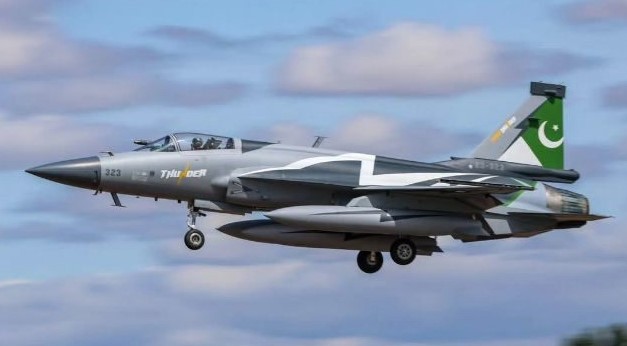A Chinese-built JF-17 fighter jet, used by the Pakistan Air Force, has landed in the United Kingdom for the very first time.
Eye-Catching JF-17 Debut at RIAT-2025
This aircraft has arrived to take part in the Royal International Air Tattoo (RIAT) 2025, one of the most prestigious airshows in the world. What immediately caught the public’s attention was the jet’s striking camouflage design, which is quite different from what military planes usually wear.
Photos and videos of the aircraft landing in the UK have already begun to circulate widely on social media.
The designers painted the jet in a two-tone gray color scheme with a bold white thunderbolt stripe across its wings. They gave it a green tail displaying the Pakistani flag, making it easily identifiable. Bold lettering beneath the cockpit spells out the word “Thunder,” matching the aircraft’s official name—JF-17 Thunder. To give the nose section a distinctive look, they highlighted it in a darker shade of gray, as it houses the radar.
This eye-catching paint job likely serves international displays like RIAT and does not reflect the standard look of operational jets in Pakistan. Usually, these aircraft carry more muted, military-themed gray or green paint jobs. In previous RIAT events, Pakistan has mainly shown off transport aircraft, such as the C-130 Hercules. This year, however, the spotlight is on the JF-17 Thunder.
Pakistan dumps Chinese J-35 jet after U.S. pressure and India war setback
Advanced Technology on Display
The JF-17 jet at RIAT-2025 is the latest and most advanced version, known as Block III. It features several technological upgrades, making it more capable than earlier models. One of its standout features is the new AESA (Active Electronically Scanned Array) radar. This radar can track up to 15 targets and engage four at the same time. It also makes the aircraft better at resisting electronic jamming.
The cockpit of the JF-17 Block III is designed with modern systems that help the pilot handle complex missions. It includes three color screens, a head-up display that shows flight information right in front of the pilot’s eyes, and a system called HOTAS (Hands On Throttle And Stick), which helps the pilot fly and fight without moving their hands away from the controls. Newer versions of the jet also have a helmet-mounted display, allowing the pilot to lock on to targets just by looking at them.
Engineers designed the JF-17 as a multi-role fighter capable of performing various missions like air combat, bombing, anti-ship attacks, and reconnaissance. They equipped it with seven hardpoints to carry weapons or fuel and armed it with a twin-barrel 23-mm gun, along with a mix of Chinese and Western missiles.
US Sanctions Over Pakistan’s Missile Program is a Veiled Warning to China
They built its lightweight airframe mostly from aluminum and added composite materials in newer models to improve performance. The jet is about 15 meters long, has a 9.5-meter wingspan, and can fly at speeds up to Mach 1.6, reaching altitudes of 16,700 meters.
Powered by a Russian RD-93 engine, the JF-17 offers a high thrust-to-weight ratio for fast climbs and sharp turns. Its delta wing design and wing-root extensions boost stability during high-angle maneuvers.
Global Stage for JF-17 Thunder
Pakistan and China jointly created the JF-17 Thunder through close cooperation. They developed it to replace older aircraft in the Pakistan Air Force, such as the Mirage III, Nanchang A-5, and Chengdu F-7. While the idea for the jet began in the late 1980s, the real work started in 1999 when the two countries signed a joint development agreement. The first prototype flew in 2003, and the aircraft officially entered service in 2007.
The designers aimed to make the aircraft cost-effective, reliable, and easy to maintain. They built it with affordability in mind, especially for countries seeking modern capabilities without the high costs of Western fighter jets. Its modular design allows operators to choose and install different radars, weapons, and electronic systems based on their needs.
RIAT Showcases Pakistan’s Air Power
At RIAT-2025, the JF-17 is expected to take part in both flight demonstrations and static displays. This means visitors will get to see it up close on the ground and watch it fly complex routines in the sky. Its participation marks a shift in the Pakistan Air Force’s approach at international airshows, moving from showing cargo planes to advanced fighter jets.
The JF-17 Thunder, also known in China as the Chengdu FC-1 Xiaolong, is a strong symbol of successful military cooperation between China and Pakistan. Its appearance at RIAT-2025 in a bold, attention-grabbing camouflage underscores the efforts of both countries to present the jet as a competitive option on the international stage.
In addition to the fighter, the Pakistan Air Force is also showing off a Lockheed C-130H transport aircraft at the event. Organizers often paint these planes with creative artwork to attract visitors and highlight different themes.
The Royal Air Force hosts the Royal International Air Tattoo each year at RAF Fairford in Gloucestershire, UK. It draws aircraft and aviation enthusiasts from all over the world. The event provides a chance for countries to demonstrate their technological capabilities and showcase national pride through the aircraft they bring.

